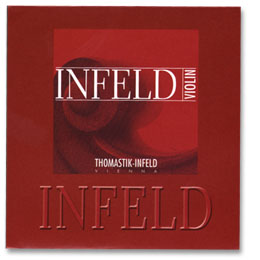Infeld Strings - Little Guide
Infeld A new generation of strings: Until now, violinists have influenced the sound of individual strings and their violin as a whole using a combination of strings with varying tension levels (high, medium, low) or strings from different manufacturers. Due to the vastly different properties of each string, both strategies significantly affected the tonal balance of the instrument, requiring the violinist or violin maker to optimize the instrument through a lengthy process of trial and error. Different strings meant different playing times and varying lifespans. Responsiveness was also inconsistent. The result was that, for the violinist, the strings did not behave as a balanced whole, with each string reacting unevenly to their playing. With Thomastik-Infeld's Infeld Violin, string types can be changed at will, allowing the violinist to easily influence the overall tonal balance of their instrument while maintaining finely tuned playing characteristics. Currently, there are two types of Infeld strings, with the red series tending to produce a darker sound on the majority of violins, while the blue set tends to bring out brilliance in the instrument. Tonal balance, playing characteristics at any position, and string response are all excellent. This is made possible through consistent string tension at different pitches and design parameters that balance the overall performance of the set independently of the string combination. With the INFELD VIOLIN system, both the violinist and violin maker will find that the instrument can be optimized in no time. The Infeld Violin system offers the player several advantages:
The central problem is that some violins are very sensitive to different thicknesses of the E string. Our recommendation, when stringing, is to start with the E string. The E string provided with the set is a good choice for the majority of instruments. (By the way, the ball end of the E string can be removed by finger pressure, so the string can be used with a ball end or loop as needed). E strings with different diameters are available on request as CUSTOM ORDER STRINGS. Now, the G string should be changed, followed by the D string and finally the A string. Technical Features: There are two types of E strings. The gold-plated E string is manufactured using a special process that significantly improves its performance and sound compared to conventional gold-plating methods. The "silver" E strings are tin-plated, allowing their sound characteristics to come to the forefront unaffected. The rest of the strings have a composite core that fulfills all the functional characteristics expected of a great string. The first winding of the string consists of an alloy that occurs naturally in nature, which is why it is called a "natural alloy." Centuries ago, this type of alloy was considered to have special properties. The G string is wound in pure silver, ensuring optimal density. The A and D strings are made with an alloy called Hydronalium, which provides good bowing response and an excellent balance between volume and bowed string sound. Recommendations and Tips: For optimal response after fitting a set, all the strings should be cleaned with a dry cloth before playing. A microfiber cloth is highly recommended. To improve stability and readiness for concert use, each string should be lightly heated after changing and tuned by moving the thumb up and down the string about five times, applying slight pressure. The instrument should then be re-adjusted, and this process repeated three times. Bending near the bridge with significant pressure (up to five times per piece) will prepare the strings for concert use in the shortest possible time. Experience has shown that strings made in this way can be made concert-ready in less than two minutes before three hours. However, it should be noted that these preparatory measures may shorten the tonal lifespan of the strings and should only be used when circumstances require a quick setup. The first strings to be put on should be those whose sound characteristics (soft or brilliant) the player increasingly considers important for their instrument. It should be noted that on certain instruments, a particular string may respond differently than expected. For example, the brilliant G string (blue) can produce either a brilliant or dark tone, depending on the instrument, as sometimes the frequency characteristics of the violin itself do not match those of the string. This problem can generally be solved by using a string in the Infeld Violin system that achieves the desired sound balance in almost all cases. If one or more strings prove to be acoustically unsuitable for a particular instrument, the following procedure has been very successful: The central problem is that some violins are very sensitive to different thicknesses of the E string. Our recommendation, when stringing, is to start with the E string. The E string provided with the set is a good choice for the majority of instruments. (By the way, the ball end of the E string can be removed by finger pressure, so the string can be used with a ball end or loop as needed). E strings with different diameters are available on request as CUSTOM ORDER STRINGS. Now, the G string should be changed, followed by the D string, and finally the A string. |
Copyright © 2006-2024 Meistervioline.com - Online store for string instruments & accessories Trusted Shops certified since 2017Shopsystem: Zen Cart




